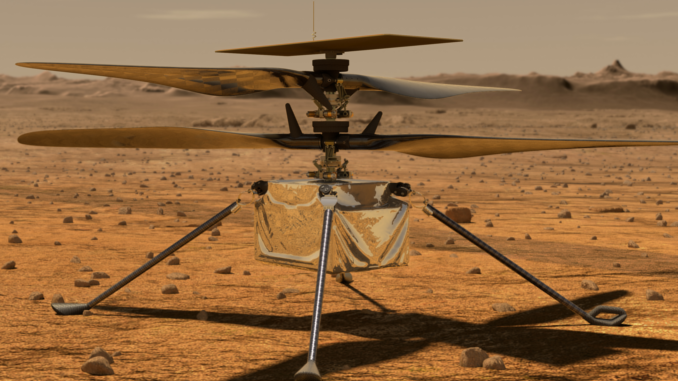
NASA’s Perseverance has a little buddy hitching a ride to Mars, to keep the rover company. NASA’s Mars Helicopter (yes, that seems to be the official agency-sanctioned name) was attached to the belly of the rover on April 6 at Kennedy Space Center. The semi-autonomous helicopter carries no scientific instruments but does have a high-resolution color camera: no word on whether selfies will be taken. Mars Helicopter has been under development since 2013 at NASA’s Jet Propulsion Laboratory (JPL) in Pasadena, California.
The technology demonstrator’s only objective is to prove that powered flight is possible on Mars, which has an atmosphere less than one one-hundreth as dense as Earth’s atmosphere. If powered flight is proven possible, future Mars rovers may have helicopters that scout the surrounding territory for them. The rover’s time on the ground could then be put to the best possible use exploring the most interesting sites found by the scout helicopter, which might otherwise be missed. Another possibility would be helicopters that carried their own science instruments enabling them to explore terrain not accessible to the rover.
It has often been said that “Helicopters don’t fly, they beat the air into submission” (author unknown, but the quote is at least 50-60 years old) and it will never be truer than on Mars.
The rotor blades of the craft, which provide lift to get it into the air, spin about 10 times faster than any Earth helicopter. They are approximately 1.2 meters (4 feet) long (tip-to-tip) and are designed for an air density on Mars that is equivelant to Earth’s air density at an altitude of 30 kilometers (roughly 100,000 feet or 18.6 miles). No helicopter on Earth has ever flown that high – the record is 12.44 kilometers (40,820 feet or 7.73 miles).
The little helicopter weighs just 1.8 kilograms (a hair under 4 pounds) and the size of the ‘body’ is comparable to a softball. It gets power to turn the rotors and operate all its electronics from on-board lithium-ion batteries, which are recharged by its own solar array.
The United States achieved the first powered heavier-than-air flight on Earth, and it now appears the USA could be the first to achieve that historic milestone on another planet.
The liftoff window runs July 17 through August 5, 2020. If liftoff occurs on schedule, the pair will touchdown in Jezero Crater on February 18, 2021.
Question of the night: Have you ever flown in a helicopter?

1 Trackback / Pingback
Comments are closed.